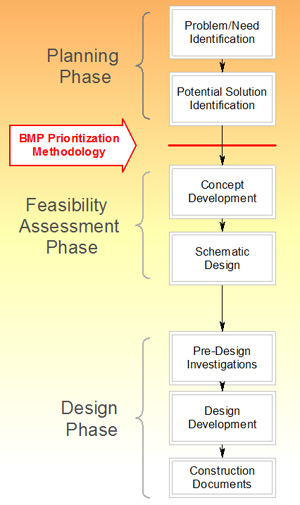Methodology
The Methodology is a high-level, conceptual planning tool developed to help watershed groups, municipalities and regulators identify and prioritize structural BMP implementation.
The Methodology was designed to:
- Address wet-weather conditions only. However, some dry weather flow benefits would indirectly be gained through wet-weather structural BMP implementation;
- Apply to all watershed within Los Angeles County;
- Be semi-automated and GIS-based;
- Use existing data to the maximum extent possible;
- Be flexible and transparent so that stakeholders and stormwater managers throughout LA County can quickly adapt the method to their watershed needs and goals;
- Be used in an iterative manner so that users can run multiple scenarios for their watershed;
- Be adaptive so that future information can be incorporated into the Methodology as our knowledge and data sources improve; and
- Be easily accessible and useable by many stakeholders within Los Angeles County. A free comprehensive guidance document (complete with examples and references) available on-line is a key work product of this project.
In general, the Methodology is comprised of the following four steps:
- Prioritize catchments based on need (i.e., pollutant-loading, receiving water issues, etc.);
- Identify potential BMPs opportunities within high priority catchments (based on factors such as land ownership, etc.);
- Identify appropriate BMPs (based on factors such as cost, maintenance, effectiveness, etc.); and
- Develop site-specific implementation strategies (based on site-specific evaluations).
Specifically, the Methodology ranks subcatchments of a watershed based on two factors: 1) need for a BMP project and 2) opportunity for BMP project. GIS is used to automate the processing of data critical to identifying high priority catchments within a watershed (using data such as land use, pollution generation, hydrology, existing downstream impairments, etc), and to identifying opportunities for BMP placement (using data such as parcel ownership, land use, roadway type, upgradient drainage area, storm drain proximity, etc.). The Methodology then combines a high-priority catchment map with an opportunity map to generate a high-priority project map. The Methodology also evaluates and scores various types of BMPs based on expected effectiveness, cost, maintenance requirements, and other criteria using information from such sources as the EPA/ASCE International BMP Database. Finally, the tool contains both “desk-top”- and field-level steps which apply systematic processes for data verification and screening-level fatal flaw analysis for those identified high-priority projects.
Products generated by the Methodology include:
- Ranked list of specific BMP projects based on their potential for reducing runoff pollution within a watershed. The identified projects have been preliminarily field-verified and screened for fatal flaws.
- Maps of high-priority catchments – those catchments that generate high pollutant loads and rated a high score for BMP project placement opportunity.
- Data and documentation to help support final design development.
Intended Use Of The Methodology
The Methodology is intended to be used as a high-level, conceptual planning tool for developing BMP implementation strategies on the watershed scale (Figure 1). Ranked project lists generated by the Methodology can serve many purposes such as: ensuring that limited funds for BMP implementation are spent in a manner that maximizes water quality benefits; investigating the impact of different implementation strategies; and assisting watersheds groups in responding to and securing funding for water quality projects as funding opportunities arise.

Figure 1
Use of the Methodology within the General Project Planning and Design Process |